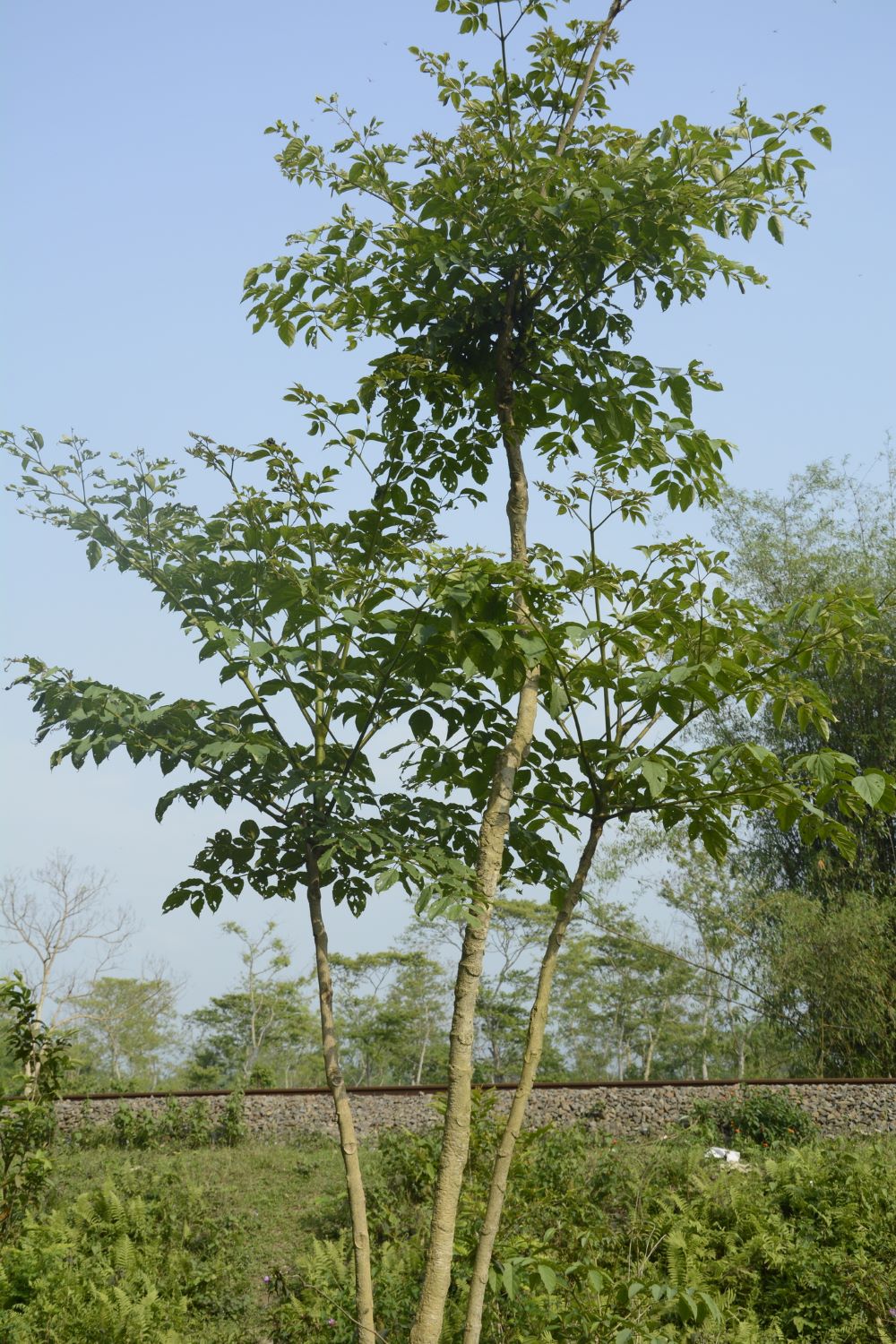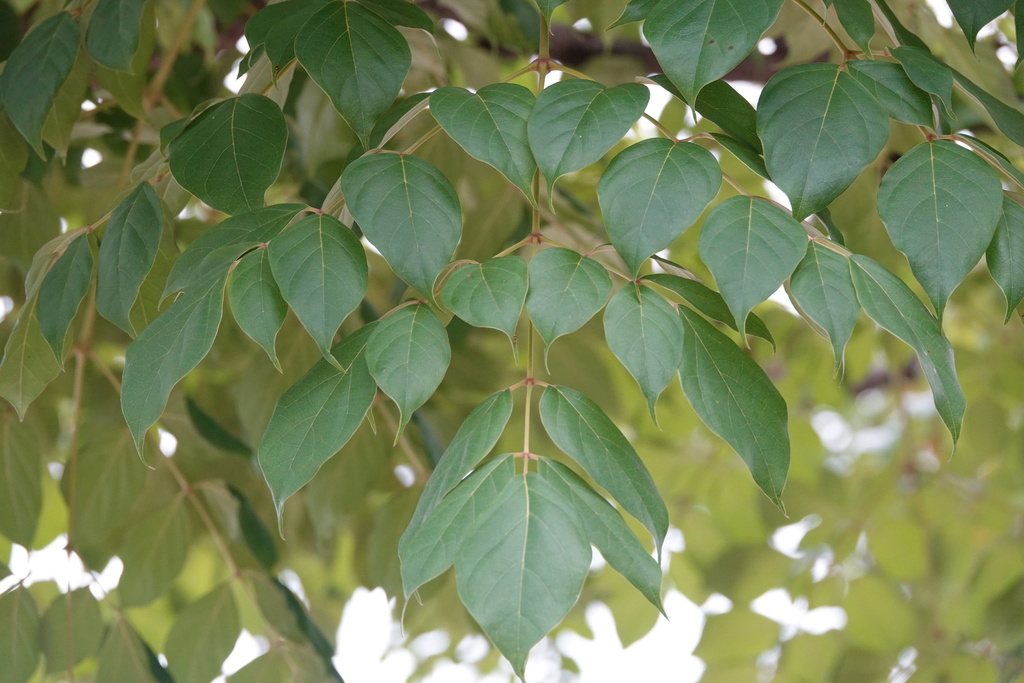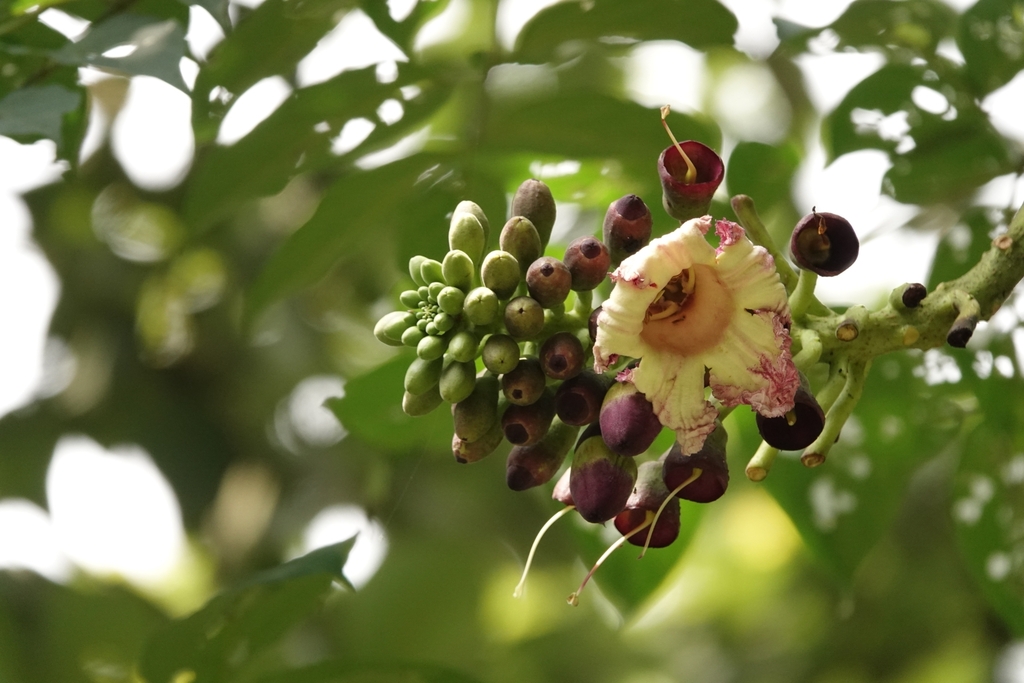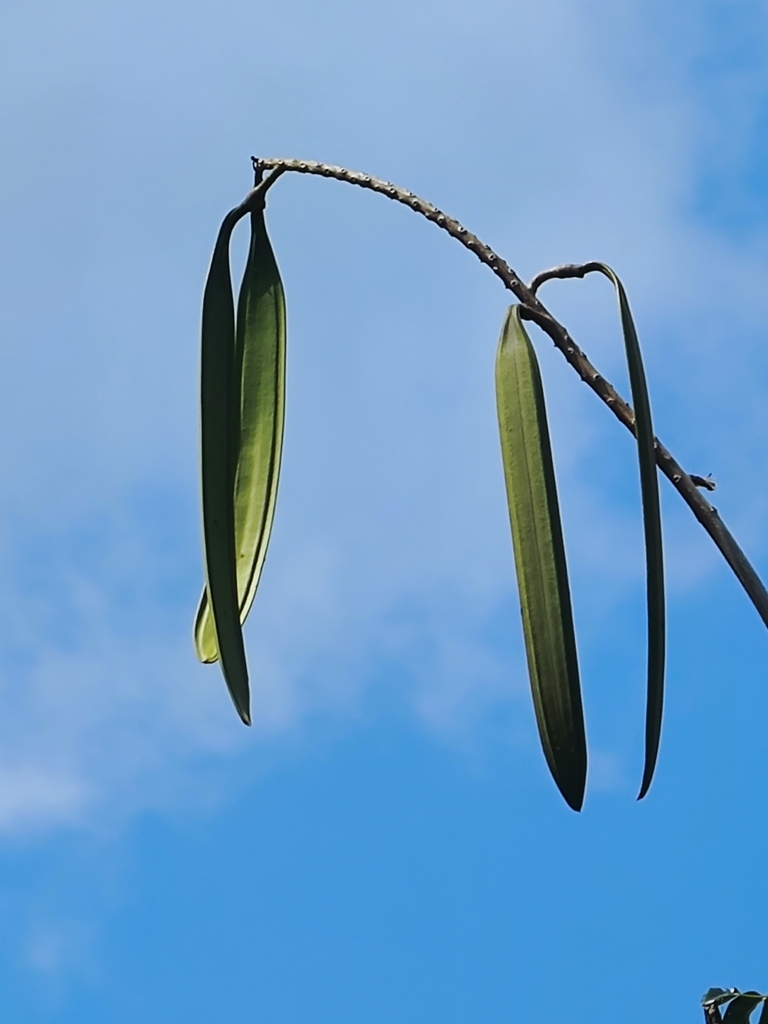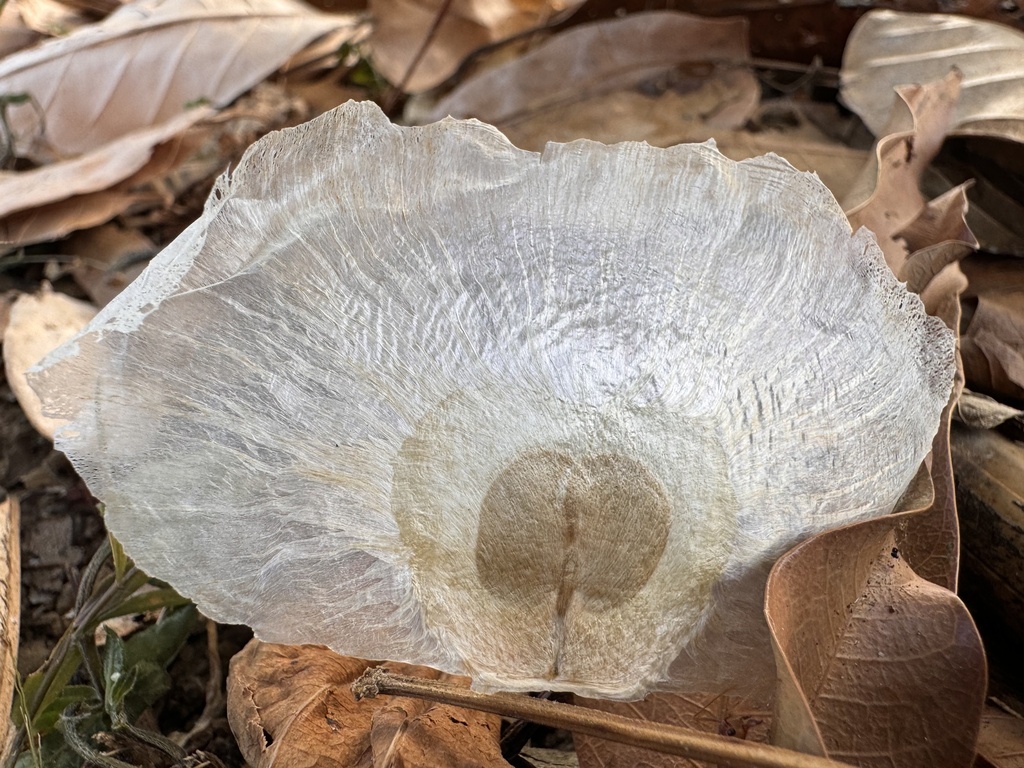ເລກລຳດັບທີ: 501
ລະດັບການຮວບຮວມຂໍ້ມູນ: ຂໍ້ມູນລະອຽດ
ປັບປູງຄັ້ງລ່າສຸດ: N/A
ໝາກລິນໄມ້
Indian Trumpet Tree
Oroxylum indicum (L.) Kurz
ພືດ
ໄມ້ຢືນຕົ້ນ
ຕົ້ນໄມ້ ແລະ ປາມ
×
ຊື່ທ້ອງຖີ່ນ:
ອື້ງກາ, ຕັ່ງປັດ (ຜູ້ນ້ອຍ) ( Indian trumpet flower.)
ຊື່ພ້ອງ
:
Arthrophyllum ceylanicum Miq.
Arthrophyllum reticulatum Blume
Arthrophyllum reticulatum Blume ex Miq.
Bignonia indica L.
Bignonia lugubris Salisb.
Bignonia pentandra Lour.
Bignonia quadripinnata Blanco
Bignonia tripinnata Noronha
Bignonia tuberculata Roxb.
Bignonia tuberculata Roxb. ex DC.
Calosanthes indica (L.) Blume
Hippoxylon indica (L.) Raf.
Oroxylum flavum Rehder
Oroxylum indicum (L.) Vent.
Spathodea indica (L.) Pers.
Arthrophyllum reticulatum Blume
Arthrophyllum reticulatum Blume ex Miq.
Bignonia indica L.
Bignonia lugubris Salisb.
Bignonia pentandra Lour.
Bignonia quadripinnata Blanco
Bignonia tripinnata Noronha
Bignonia tuberculata Roxb.
Bignonia tuberculata Roxb. ex DC.
Calosanthes indica (L.) Blume
Hippoxylon indica (L.) Raf.
Oroxylum flavum Rehder
Oroxylum indicum (L.) Vent.
Spathodea indica (L.) Pers.
ຊື່ສະກຸນ:
Bignoniaceae
ຊະນິດໃກ້ຄຽງ:
ບັນຍາຍລັກສະນະທາງພືດສາດ:
ຕົ້ນໝາກລິນໄມ້ເປັນໄມ້ຢືນຕົ້ນຂະໜາດນ້ອຍຫາປານກາງ ທີ່ມີຄວາມສູງປະມານ 5 ຫາ 10 ມ. ເສັ້ນຜ່າສູນກາງ 15 ຫາ 20 ຊມ. ເມື່ອຍັງອ່ອນມັກຈະອອກເປັນຕົ້ນດ່ຽວ ມີໃບໃຫຍ່ອອກຢູ່ບໍຣິເວນປາຍຍອດ ເຮັດໃຫ້ມີລັກສະນະຄ້າຍກັບຕົ້ນປາມ. ເປືອກບາງ ແລະ ມີສີນ້ຳຕານປົນສີເທົາ.
ໃບແມ່ນໃບປະສົມ, ມີຂະຫນາດໃຫຍ່, ຂະໜາດ 60 ຫາ 170 ຊມ. ໃບຍ່ອຍຈຳນວນຫຼາຍ, ຮູບຮີ ຫຼື ສາມຫຼຽມ, ຍາວ 5 ຫາ 13 ຊມ. ແລະ ກວ້າງ 3 ຫາ 10 ຊມ. ເມື່ອແກ່ໃບຈະມີຂະໜາດນ້ອຍ (ປະມານ 5 ຫາ 20 ມິນລິແມັດ) ມັກຈະປ່ຽນເປັນສີນຳເງິນແຫຼມ.
ຕົ້ນໄມ້ຊະນິດນີ້ມີຊໍ່ດອກ (inflorescences) ຍາວ ແລະ ຕັ້ງຊື່, ອອກບໍລິເວນປາຍຍອດ, ຍາວ 40 ຫາ 150 ຊມ. ດອກຮູບຈວຍ, ໜາ ແລະ ມີເນື້ອອວບນ້ຳ. ບານໃນຕອນກາງຄືນ ແລະ ມີກິ່ນແຮງ ແລະ ບໍ່ມີກິ່ນຫອມ. ດອກຍ່ອຍມີຄວາມຍາວ 3 ຫາ 9 ຊມ ແລະ ກວ້າງ 1 ຫາ 10 ຊມ, ປາຍແຍກອອກເປັນ 5 ແສກປາຍຫຍັບແຫຼມ, ສີເຫຼືອງອ່ອນ ຫຼື ສີມ່ວງແດງ.
ໝາກເປັນຝັກຫຍາວ, ສີນ້ຳຕານເຂັ້ມ, ຮູບແຖບຍາວ, ຍາວ 40 ຫາ 120 ຊມ, ກວ້າງ 5 ຫາ 9 ຊມ ແລະ ໜາປະມານ 1 ຊມ. ໃນແຕ່ລະຝັກມີແກ່ນຈຳນວນຫຼາຍ ທີ່ເປັນຮູບບາງຫຼຽບ ແລະ ມີປີບາງຫຸ້ມຢູ່, ຂະຫນາດປະມານ 4 ຫາ 8 ຊມ ແລະ ກວ້າງ 3 ຫາ 5 ຊມ.
ແຫຼ່ງທີ່ມາ: [1]
ໃບແມ່ນໃບປະສົມ, ມີຂະຫນາດໃຫຍ່, ຂະໜາດ 60 ຫາ 170 ຊມ. ໃບຍ່ອຍຈຳນວນຫຼາຍ, ຮູບຮີ ຫຼື ສາມຫຼຽມ, ຍາວ 5 ຫາ 13 ຊມ. ແລະ ກວ້າງ 3 ຫາ 10 ຊມ. ເມື່ອແກ່ໃບຈະມີຂະໜາດນ້ອຍ (ປະມານ 5 ຫາ 20 ມິນລິແມັດ) ມັກຈະປ່ຽນເປັນສີນຳເງິນແຫຼມ.
ຕົ້ນໄມ້ຊະນິດນີ້ມີຊໍ່ດອກ (inflorescences) ຍາວ ແລະ ຕັ້ງຊື່, ອອກບໍລິເວນປາຍຍອດ, ຍາວ 40 ຫາ 150 ຊມ. ດອກຮູບຈວຍ, ໜາ ແລະ ມີເນື້ອອວບນ້ຳ. ບານໃນຕອນກາງຄືນ ແລະ ມີກິ່ນແຮງ ແລະ ບໍ່ມີກິ່ນຫອມ. ດອກຍ່ອຍມີຄວາມຍາວ 3 ຫາ 9 ຊມ ແລະ ກວ້າງ 1 ຫາ 10 ຊມ, ປາຍແຍກອອກເປັນ 5 ແສກປາຍຫຍັບແຫຼມ, ສີເຫຼືອງອ່ອນ ຫຼື ສີມ່ວງແດງ.
ໝາກເປັນຝັກຫຍາວ, ສີນ້ຳຕານເຂັ້ມ, ຮູບແຖບຍາວ, ຍາວ 40 ຫາ 120 ຊມ, ກວ້າງ 5 ຫາ 9 ຊມ ແລະ ໜາປະມານ 1 ຊມ. ໃນແຕ່ລະຝັກມີແກ່ນຈຳນວນຫຼາຍ ທີ່ເປັນຮູບບາງຫຼຽບ ແລະ ມີປີບາງຫຸ້ມຢູ່, ຂະຫນາດປະມານ 4 ຫາ 8 ຊມ ແລະ ກວ້າງ 3 ຫາ 5 ຊມ.
ແຫຼ່ງທີ່ມາ: [1]
ນິເວດວິທະຍາ
ເຂດກະຈາຍພັນທົ່ວໂລກ:
Native to Andaman Is., Assam, Bangladesh, Borneo, Cambodia, China South-Central, China Southeast, East Himalaya, India, Jawa, Laos, Lesser Sunda Is., Malaya, Myanmar, Nepal, Philippines, Sri Lanka, Sulawesi, Sumatera, Thailand, Vietnam, West Himalaya. [2]
Global distribution of Oroxylum indicum between 1889 to 2025. Source: [3]
Global distribution of Oroxylum indicum between 1889 to 2025. Source: [3]
ເຂດກະຈາຍພັນໃນລາວ
:
ເຂດພູສູງພາກເໜືອຂອງລາວ
ລຽບແມ່ນ້ຳຂອງພາກເໜືອ
ເຂດພູສູງສາຍພູຫຼວງ ແລະ ເຂດພູພຽງແຂວງຊຽງຂວາງ
ທົ່ງພຽງວຽງຈັນ
ເຂດສາຍພູຫຼວງພາກເໜືອ
ເຂດສາຍພູຫຼວງຕອນລຸ່ມ
ສາຍພູຫຼວງພາກໃຕ້
ເຂດລຽບແມ່ນ້ຳຂອງພາກໃຕ້
ພູພຽງບໍລິເວນ
ເຂດສາຍພູຫຼວງພາກກາງ
ລຽບແມ່ນ້ຳຂອງພາກເໜືອ
ເຂດພູສູງສາຍພູຫຼວງ ແລະ ເຂດພູພຽງແຂວງຊຽງຂວາງ
ທົ່ງພຽງວຽງຈັນ
ເຂດສາຍພູຫຼວງພາກເໜືອ
ເຂດສາຍພູຫຼວງຕອນລຸ່ມ
ສາຍພູຫຼວງພາກໃຕ້
ເຂດລຽບແມ່ນ້ຳຂອງພາກໃຕ້
ພູພຽງບໍລິເວນ
ເຂດສາຍພູຫຼວງພາກກາງ

ເຂດກະຈາຍພັນຕາມພູມສັນຖານ
:
ປ່າດົງດິບ
ປ່າປະສົມປ່ຽນໃບ
ປ່າປູກ
ແຄມຝັ່ງນໍ້າ
ປ່າປະສົມປ່ຽນໃບ
ປ່າປູກ
ແຄມຝັ່ງນໍ້າ
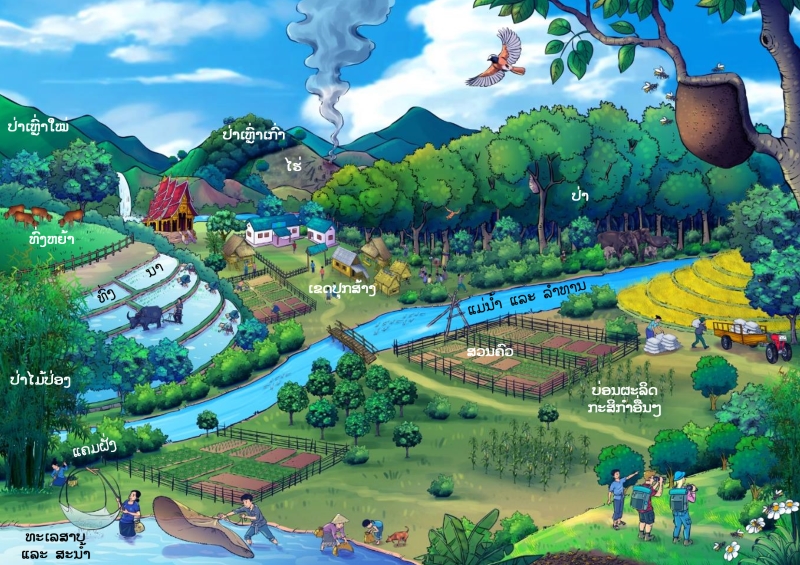
ສະເພາະຖິ່ນໃນລາວ:
ພື້ນເມືອງ
ຮຸກຮານ
:
ບໍ່ຮຸກຮານ
ສະຖານະພາບການອະນູຮັກ IUCN
:
ມີຄວາມສ່ຽງໜ້ອຍສຸດ
ສະຖານະພາບການອະນຸຮັກແຫ່ງຊາດລາວ
:
ບໍ່ຖືກລະບຸໃນບັນຊີປະເພດໃດ
ການນຳໃຊ້
ປະເພດການນຳໃຊ້:
ອາຫານ
ພືດເປັນຢາ
ພືດເປັນຢາ
ບັນຍາຍການນຳໃຊ້:
ອາຫານ: ໃບອ່ອນ, ດອກ ແລະ ໝາກອ່ອນມີຣົດຊາດຂົມ ນິຍົມນຳມາໃຊ້ໃນການປຸງອາຫານແບບດັ້ງເດີມ. ໂດຍມັກນຳໄປປີ້ງ ຫຼື ຕົ້ມກິນກັບແຈ່ວ [4], ໝາກອ່ອນມັກນຳໄປເຮັດຍຳ [7] ແລະ ລາບ [8]. ກິນເປັນຜັກ, ຜົນອ່ອນມັກນຳມາເຜົາໄຟ, ປອກເປືອກ ແລ້ວຊອຍເປັນຕ່ອນນ້ອຍໆກິນກັບລາບ. ໃນເມືອງປາຊ່ອງ, ໝາກອ່ອນຍັງຖືກນຶ້ງກິນກັນຢ່າງແຜ່ຫຼາຍ, ດອກມີຣົດຂົມນັ້ນກໍ່ກິນໄດ້ເຊັ່ນກັນ ໂດຍນຳໄປຂົ້ວໄດ້ ແຕ່ສ່ວນໃຫຍ່ມັກນຶ່ງ ແລະ ນຳໄປຍັດເນື້ອສັດເປັນອົ່ວ. [9]
ສະໝຸນໄພ: ທຸກສ່ວນຂອງພືດຕົ້ນລິນໄມ້ມີສັບພະຄຸນທາງສະໝຸນໄພ. ໂດຍເພາະໝາກອ່ອນ ຊ່ວຍຕ້ານອະນຸມູນອິດສະລະ ລົດຄວາມເສຍຫາຍຂອງຈຸລັງ, ຊ່ວຍຍ່ອຍອາຫານ, ສົ່ງເສີມສຸຂະພາບຂອງດວງຕາ ແລະ ໂພຊະນາການໂດຍລວມ. ນອກຈາກນັ້ນຍັງຊ່ວຍຫຼຸດການອັກເສບ ແລະ ບັນເທົາອາການເຈັບຄໍ, ບັນເທົາອາການໄອ ແລະ ຂັບສຽບຫະ, ຮັກສາອາການກ່ຽວກັບລະບົບທາງເດີນອາຫານ ເຊັ່ນ ທ້ອງອືດ ແລະ ທ້ອງສຽບ, ຮັກສາແຜ່ໃນຊ່ອງປາກ, ເປັນຢາລະບາຍອ່ອນໆ, ຊ່ວຍລະບາຍຄວາມຮ້ອນ ແລະ ອາດຊ່ວຍປ້ອງກັນ ຫຼືຮັກສາໂຣກມະເຮັງ. ແກ່ນໃຊ້ໃນການບັນເທົາໄອ ແລະ ເຈັບຄໍ, ຫຼຸດອາການທ້ອງອືດ ແລະ ກະຫາຍນ້ຳນ້ຳ, ເປັນຢາລະບາຍອ່ອນໆ ແລະ ຊ່ວຍຂັບສານພິດໃນລຳໄສ້. ຢອດອ່ອນ ຫຼື ໃບອ່ອນຊ່ວຍລົດໄຂມັນໃນເລືອດ ຊ່ວຍເຮັດໃຫ້ລະບົບຫົວໃຈ ແລະ ຫຼອດເລືອດໃຫ້ແຂງແຮງ, ຊ່ວຍກຳຈັດພິດສະສົມ, ແກ້ຫວັດ ແລະ ຊ່ວຍສະໝານແຜພາຍນອກ. ເນື້ອໄມ້ແລະເປືອກຖືກນຳໃຊ້ຮັກສາລິດຊີດວງທະວານ, ບັນເທົາອາການມວນທ້ອງ ແລະ ປວດຮາກ, ລົດອາການທ້ອງອືດ. ຮາກນຳມາບົດໃຫ້ລະອຽດແລ້ວໃຊ້ທາຮັກສາຝີ ແລະ ກະຕຸ້ນຄວາມຢາກອາຫານ. [4]
ສະໝຸນໄພ: ທຸກສ່ວນຂອງພືດຕົ້ນລິນໄມ້ມີສັບພະຄຸນທາງສະໝຸນໄພ. ໂດຍເພາະໝາກອ່ອນ ຊ່ວຍຕ້ານອະນຸມູນອິດສະລະ ລົດຄວາມເສຍຫາຍຂອງຈຸລັງ, ຊ່ວຍຍ່ອຍອາຫານ, ສົ່ງເສີມສຸຂະພາບຂອງດວງຕາ ແລະ ໂພຊະນາການໂດຍລວມ. ນອກຈາກນັ້ນຍັງຊ່ວຍຫຼຸດການອັກເສບ ແລະ ບັນເທົາອາການເຈັບຄໍ, ບັນເທົາອາການໄອ ແລະ ຂັບສຽບຫະ, ຮັກສາອາການກ່ຽວກັບລະບົບທາງເດີນອາຫານ ເຊັ່ນ ທ້ອງອືດ ແລະ ທ້ອງສຽບ, ຮັກສາແຜ່ໃນຊ່ອງປາກ, ເປັນຢາລະບາຍອ່ອນໆ, ຊ່ວຍລະບາຍຄວາມຮ້ອນ ແລະ ອາດຊ່ວຍປ້ອງກັນ ຫຼືຮັກສາໂຣກມະເຮັງ. ແກ່ນໃຊ້ໃນການບັນເທົາໄອ ແລະ ເຈັບຄໍ, ຫຼຸດອາການທ້ອງອືດ ແລະ ກະຫາຍນ້ຳນ້ຳ, ເປັນຢາລະບາຍອ່ອນໆ ແລະ ຊ່ວຍຂັບສານພິດໃນລຳໄສ້. ຢອດອ່ອນ ຫຼື ໃບອ່ອນຊ່ວຍລົດໄຂມັນໃນເລືອດ ຊ່ວຍເຮັດໃຫ້ລະບົບຫົວໃຈ ແລະ ຫຼອດເລືອດໃຫ້ແຂງແຮງ, ຊ່ວຍກຳຈັດພິດສະສົມ, ແກ້ຫວັດ ແລະ ຊ່ວຍສະໝານແຜພາຍນອກ. ເນື້ອໄມ້ແລະເປືອກຖືກນຳໃຊ້ຮັກສາລິດຊີດວງທະວານ, ບັນເທົາອາການມວນທ້ອງ ແລະ ປວດຮາກ, ລົດອາການທ້ອງອືດ. ຮາກນຳມາບົດໃຫ້ລະອຽດແລ້ວໃຊ້ທາຮັກສາຝີ ແລະ ກະຕຸ້ນຄວາມຢາກອາຫານ. [4]
ການປູກ ການລ້ຽງ:
ປູກ ແລະ ທຳມະຊາດ
ລະດູການເກັບກູ້:
ມີນາ
ເມສາ
ພຶກສະພາ
ມິຖຸນາ
ກໍລະກົດ
ເມສາ
ພຶກສະພາ
ມິຖຸນາ
ກໍລະກົດ
ການຕະຫຼາດ ແລະ ຕ່ອງໂສ້ມູນຄ່າ:
ໝາກລິນໄມ້ເປັນສິນຄ້າທີ່ຈຳໜ່າຍໃນຕະຫຼາດທ້ອງຖິ່ນ ຫຼື ໃຊ້ບໍລິໂພກໃນຄົວເຮືອນ. ໃນປະເທດລາວ ແລະ ພາກຕາເວັນອອກສ່ຽງເໜືອຂອງປະເທດໄທ, ໝາກລິນໄມ້ 10 ໜ່ວຍມັກຖືກຂາຍໃນລາຄາປະມານ 17,000 ກີບ, ໃນຂະນະທີ່ລາຄາໃນເມືອງໃຫຍ່ອາດຈະສູງຂຶ້ນເຖິງ 55,000 ກີບ. [1]
ການຄຸ້ມຄອງຈັດການ
ຊະນິດພັນທີມີການປູກ
ສະພາບໂດຍລວມ:
ໝາກລິໄມ້ສາມາດຂະຫຍາຍພັນໄດ້ 3 ວິທີຫຼັກ ຄື: ການປູກດ້ວຍແກ່ນ, ການປັກຊຳກິ່ງ ແລະ ການປັກຊຳຮາກ. [4]
ການຄັດເລືອກສາຍພັນ:
ການຂະຫຍາຍພັນໂດຍການເພາະແກ່ນ:
• ຕົ້ນໝາກລິນໄມ້ ສາມາດເພາະພັນໄດ້ຈາກແກ່ນສຸກເຕັມທີ່ແລ້ວ ຫຼື ເກັບກ່ຽວໃນໄລຍະເດືອນພະຈິກເຖິງເດືອນທັນວາ. ເພື່ອໂອກາດໃນການງອກ, ຕັດບາງສ່ວນຂອງປີກຂອງໝາກອອກ ແລ້ວແຊ່ໃນນ້ຳເຢັນປະມານ 12 ຊົ່ວໂມງ ຫຼື ຄ້າງຄືນ
• ນໍາແກ່ນພັນທີ່ກຽມໄວ້ມາຫວ່ານໃນໜານເພາະກ້າ ແລ້ວຖົມດ້ວຍດິນໜາປະມານ 2 ຊມ. ຫຼື ອີກວິທີໜຶ່ງ, ສາມາດໃສ່ແກ່ນພັນ 2 ໜ່ວຍລົງໃນຖົງກ້າເບ້ຍໄມ້ເພື່ອຫຼຸດຄວາມສ່ຽງການເນົ່າ ຫຼື ບໍ່ງອກ.
• ຫຼັງຈາກຫວ່ານແລ້ວແກ່ນຈະງອກພາຍໃນ 15–20 ວັນ, ເຊິ່ງຈະມີໃບນ້ອຍໆ ໂຜ່ອອກມາ ໝາຍຄວາມວ່າຕົ້ນກໍາລັງເຕີບໂຕໄດ້ດີ. ເມື່ອຕົ້ນແຂງແຮງດີ ແລ້ວຈຶ່ງຍ້າຍໃສ່ຖົງເບ້ຍໄມ້.
• ເກັບຕົ້ນກ້າໃຫ້ຢູ່ໃນທີ່ຮົ່ມຈົນຮອດລະດູຝົນ (ປະມານ ເດືອນພຶດສະພາ ເຖິງ ເດືອນ ມິຖຸນາ) ກ່ອນຈະຍ້າຍລົງສູ່ໜານປູກ.
ການຂະຫຍາຍພັນໂດຍການປັກຊຳກິ່ງ:
• ຕົ້ນໝາກລິນໄມ້ ສາມາດຂະຫຍາຍພັນໄດ້ໂດຍການປັກຊຳກິ່ງໃນໄລຍະ ເດືອນ ມັງກອນ ເຖິງ ເດືອນ ກຸມພາ ຂອງແຕ່ລະປີ
• ຂັ້ນຕອນທຳອິດໃຫ້ກຽມສ່ວນປະສົມດິນໂດຍໃຊ້ດິນ 60%, ປຸ໋ຍຄອກ 20% ແລະ ແກບເຜົາ 20% ຄົນໃຫ້ເຂົ້າກັນແລ້ວບັນຈຸໃສ່ຖົງດຳ ຫຼື ຖົງເພາະກ້າ ແລ້ວວາງໃນເຮືອນຮົ່ມ ຫົດນ້ຳໃຫ້ຊຸ່ມເພື່ອໃຫ້ຕົ້ນປັກຊຳຂະຫຍາຍຕົວໄດ້ດີ
• ເລືອກກິ່ງທີ່ມີຄວາມແຂງແຮງ ບໍ່ແກ່ ຫຼື ອ່ອນເກີນໄປ ແລະ ມີຕາທີ່ເຫັນໄດ້ຊັດເຈນ, ໃຊ້ມີດຂະໜາດນ້ອຍ ຫຼື ຄັດເຕີຕັດກິ່ງ ໃຫ້ໄດ້ຄວາມຍາວປະມານ 8–10 ຊມ ໂດຍຕັດໃຫ້ຫ່າງຈາກຕາປະມານ 2 ຊມ, ດ້ານລຸ່ມຕັດໃຫ້ເປັນມຸມແຫຼມ ແລ້ວປັກລົງໃນຖົງເພາະກ້າເບຍໄມ້ທີ່ມີດິນ ໂດຍໃຫ້ພົ້ນຢູ່ເຫນືອຜິວດິນປະມານ 2 ຊມ
• ຫົດນ້ຳໃຫ້ຊຸ່ມທຸກວັນ ໂດຍທົ່ວໄປແລ້ວໃບໃໝ່ຈະເລີ່ມປົ່ງໃນໄລຍະ 15–20 ວັນ ແລະຄວນເກັບຕົ້ນໄວ້ໃນທີ່ຮົ່ມປະມານ 1–3 ເດືອນ ກ່ອນຍ້າຍລົງສູ່ໜານປູກ.
ການຂະຫຍາຍພັນໂດຍການປັກຊຳຮາກ:
• ຕົ້ນໝາກລິນໄມ້ ສາມາດຂະຫຍາຍພັນໄດ້ໂດຍການປັກຊຳຮາກໃນໄລຍະເດືອນມັງກອນ ແລະ ກຸມພາ
• ຂັ້ນຕອນທຳອິດຕ້ອງກຽມສ່ວນປະສົມດິນຊື່ງໃຊ້ວິທີດຽວກັນກັບການປັກຊຳກິ່ງ: ດິນ 60%, ປຸ໋ຍຄອມໂພສ 20% ແລະ ແກບເຜົາ 20% ປະສົມໃຫ້ເຂົ້າກັນ ແລ້ວໃສ່ລົງໃນຖົງກ້າເບ້ຍໄມ້.
• ຂຸດຮາກຂອງຕົ້ນໝາກລິນໄມ້ ຢ່າງລະມັດລະວັງ ໂດຍໃຊ້ສ້ຽມ, ຄັດເຕີ ຫຼື ຈົກ, ໃຫ້ໄດ້ຂະໜາດຮາກາກ 3–5 ຊມ ແລ້ວຕັດແຍກເປັນທ່ອນຂະໜາດ 8–10 ຊມ ຈາກນັ້ນນຳໄປປັກຊຳລົງໃນຖົງກາເບ້ຍໄມ້ ໂດຍໃຫ້ພົ້ນຢູ່ເຫນືອຜິວດິນປະມານ 2 ຊມ
• ເກັບຖົງເພາະກ້າເບ້ຍໄມ້ໄວ້ໃນເຮືອນຮົ່ມ ແລ້ວຫົດນ້ຳວັນລະ 1 ຄັ້ງ ຕົ້ນກ້າມັກຈະງອກພາຍໃນ 15–20 ວັນ ແລ້ວປ່ອຍໃຫ້ຕົ້ນອ່ອນເຕີບໂຕໃນເຮືອນຮົ່ມກ່ອນ 1–3 ເດືອນ ກ່ອນຈະຍ້າຍໄປປູກໃນແປງ.
ແຫຼ່ງທີ່ມາ: [4]
ການກຽມພື້ນທີ່:
ວິທີການເລີ່ມປູກໃນພື້ນທີ່ໃໝ່ມີຢູ່ 2 ວິທີ: ການໃຊ້ແຮງງານເພື່ອຖາງຫຍ້າ ແລະ ວັດສະພືດທີ່ບໍ່ຕ້ອງການອອກໂດຍບໍ່ເຜົາ, ແລະ ປ່ອຍໃຫ້ຕົ້ນໄມ້ໃຫຍ່ຢູ່ຕໍ່ ແລະ ການໃຊ້ເຄື່ອງຈັກໃນການໄຖ ແລະ ຖາງພື້ນທີ່ໂດຍການໄຖດິນເພື່ອກໍາຈັດເສດສາກພືດອອກຈາກພື້ນທີ່ ແລະ ບໍ່ຕັດຕົ້ນໄມ້ໃຫຍ່ [4]
ເມື່ອຖາງແລ້ວ ແລະ ເຮັດຄວາມສະອາດພື້ນທີ່ປູກແລ້ວ ຈໍາເປັນຕ້ອງປັກໝຸດໃຫ້ເປັນແນວຕົງເພື່ອຂຸດຂຸມ. ໃຊ້ໄມ້ໄຜ່ຍາວປະມານ 1 ແມັດ ໃຫ້ແຫຼມປາຍອີກດ້ານໜຶ່ງປັກໝາຍຂຸມໄລຍະຫ່າງປະມານ 4x4 ແມັດ. [4]
ເທັກນິກການປູກ:
ລະຍະຫ່າງທີ່ແນະນໍາໃນການປູກຕົ້ນໝາກລິນໄມ້ແມ່ນ 4 × 4 ມ. ໃຫ້ຂຸດຫຼຸມປູກໃຫ້ລຶກປະມານ 50 × 50 ຊມ. ນໍາດິນທີ່ຂຸດໄດ້ມາຜະສົມກັບຟາງ ຫຼື ໃບໄມ້ແຫ້ງ (ຖ້າເປັນໄປໄດ້ໃຫ້ໃຊ້ໃບສົດຖ້າມີ) ແລ້ວໃສ່ລົງໄປທາງກົ້ນຂຸມເພື່ອໃຫ້ຕົ້ນໄມ້ຂະຫຍາຍໂຕໄດ້ໄວ. ນຳຕົ້ນກ້າທີ່ມີອາຍຸປະມານ 2 ຫາ 3 ເດືອນມາປູກ ແລ້ວຖົມດິນໃຫ້ແນ່ນ. ຫຼັງຈາກປູກແລ້ວ ຄວນຫົດນ້ຳ ແຕ່ຄວນເຫຼືອກການຫົດນ້ຳຫຼາຍເກີນໄປ ເນື່ອງຈາກຕົ້ນໝາກລິນໄມ້ບໍ່ທົນຕໍ່ນ້ຳຫຼາຍ. [4]
ການເບິ່ງແຍງ ແລະ ບຳລຸງຮັກສາ:
ການຫົດນ້ຳ ແລະ ປຸ໋ຍ: 15 ວັນຫຼັງຈາກປູກ ໃຫ້ໃສ່ປຸ໋ຍສູດ 15-15-15 ໃນອັດຕາປະມານ 2 ກຳມືຕໍ່ຕົ້ນ ໂດຍຫວ່ານໃຫ້ກະຈັດຮອບໂຄນຕົ້ນ. ຈາກນັ້ນໃຫ້ໃສ່ປຸ໋ຍອີກຄັ້ງໃນ 30 ວັນຫຼັງຈາກປູກ ໃນອັດຕາເທົ່າເກົ່າ. ຫົດດນ້ຳທຸກວັນເວັ້ນວັນໃຫ້ດິນຊຸ່ມຢູ່ສະເໝີ. [4]
ຊະນິດພັນໃນປ່າ:
ການອານຸລັກທີ່ຢູ່ອາໄສ:
ໄພຂົ່ມຂູ່: ເນື່ອງຈາກການນໍາໃຊ້ເນື້ອ ແລະ ເປືອກຮາກຂອງພັນພືດຊະນິດນີ້ໃນການເຮັດຢາແຜນໂບຮານ ທຳໃຫ້ມັນຖືກເກັບກ່ຽວຫຼາຍເກີນໄປ ແລະ ມີຈໍານວນຂອງຫຼຸດລົງ. ນອກຈາກນັ້ນ, ພືດຊະນິດນີ້ຍັງກໍາລັງຖືກຄຸກຄາມຈາກການຂະຫຍາຍຕົວເມືອງ ແລະ ການພັດທະນາກະສິກໍາ. [6]
ການຕິດຕາມປະຊາກອນ:
ພືດຊະນິດນີ້ເຊື່ອວ່າກໍາລັງຫາຍາກໃນອິນເດຍ ເນື່ອງຈາກຄວາມຕ້ອງການເພີ່ມຂຶ້ນໃນອຸດສາຫະກໍາຜະລິດຢາ. ແຕ່ສະຖານະ ແລະ ທິດທາງຂອງປະຊາກອນພັນພືດໃນພື້ນທີ່ອື່ນໆໃນເຂດການກະຈາຍພັນ ຍັງບໍ່ມີຂໍ້ມູນຢ່າງແນ່ຊັດ. [6]
ສະພາບໂດຍລວມ:
ໝາກລິໄມ້ສາມາດຂະຫຍາຍພັນໄດ້ 3 ວິທີຫຼັກ ຄື: ການປູກດ້ວຍແກ່ນ, ການປັກຊຳກິ່ງ ແລະ ການປັກຊຳຮາກ. [4]
ການຄັດເລືອກສາຍພັນ:
ການຂະຫຍາຍພັນໂດຍການເພາະແກ່ນ:
• ຕົ້ນໝາກລິນໄມ້ ສາມາດເພາະພັນໄດ້ຈາກແກ່ນສຸກເຕັມທີ່ແລ້ວ ຫຼື ເກັບກ່ຽວໃນໄລຍະເດືອນພະຈິກເຖິງເດືອນທັນວາ. ເພື່ອໂອກາດໃນການງອກ, ຕັດບາງສ່ວນຂອງປີກຂອງໝາກອອກ ແລ້ວແຊ່ໃນນ້ຳເຢັນປະມານ 12 ຊົ່ວໂມງ ຫຼື ຄ້າງຄືນ
• ນໍາແກ່ນພັນທີ່ກຽມໄວ້ມາຫວ່ານໃນໜານເພາະກ້າ ແລ້ວຖົມດ້ວຍດິນໜາປະມານ 2 ຊມ. ຫຼື ອີກວິທີໜຶ່ງ, ສາມາດໃສ່ແກ່ນພັນ 2 ໜ່ວຍລົງໃນຖົງກ້າເບ້ຍໄມ້ເພື່ອຫຼຸດຄວາມສ່ຽງການເນົ່າ ຫຼື ບໍ່ງອກ.
• ຫຼັງຈາກຫວ່ານແລ້ວແກ່ນຈະງອກພາຍໃນ 15–20 ວັນ, ເຊິ່ງຈະມີໃບນ້ອຍໆ ໂຜ່ອອກມາ ໝາຍຄວາມວ່າຕົ້ນກໍາລັງເຕີບໂຕໄດ້ດີ. ເມື່ອຕົ້ນແຂງແຮງດີ ແລ້ວຈຶ່ງຍ້າຍໃສ່ຖົງເບ້ຍໄມ້.
• ເກັບຕົ້ນກ້າໃຫ້ຢູ່ໃນທີ່ຮົ່ມຈົນຮອດລະດູຝົນ (ປະມານ ເດືອນພຶດສະພາ ເຖິງ ເດືອນ ມິຖຸນາ) ກ່ອນຈະຍ້າຍລົງສູ່ໜານປູກ.
ການຂະຫຍາຍພັນໂດຍການປັກຊຳກິ່ງ:
• ຕົ້ນໝາກລິນໄມ້ ສາມາດຂະຫຍາຍພັນໄດ້ໂດຍການປັກຊຳກິ່ງໃນໄລຍະ ເດືອນ ມັງກອນ ເຖິງ ເດືອນ ກຸມພາ ຂອງແຕ່ລະປີ
• ຂັ້ນຕອນທຳອິດໃຫ້ກຽມສ່ວນປະສົມດິນໂດຍໃຊ້ດິນ 60%, ປຸ໋ຍຄອກ 20% ແລະ ແກບເຜົາ 20% ຄົນໃຫ້ເຂົ້າກັນແລ້ວບັນຈຸໃສ່ຖົງດຳ ຫຼື ຖົງເພາະກ້າ ແລ້ວວາງໃນເຮືອນຮົ່ມ ຫົດນ້ຳໃຫ້ຊຸ່ມເພື່ອໃຫ້ຕົ້ນປັກຊຳຂະຫຍາຍຕົວໄດ້ດີ
• ເລືອກກິ່ງທີ່ມີຄວາມແຂງແຮງ ບໍ່ແກ່ ຫຼື ອ່ອນເກີນໄປ ແລະ ມີຕາທີ່ເຫັນໄດ້ຊັດເຈນ, ໃຊ້ມີດຂະໜາດນ້ອຍ ຫຼື ຄັດເຕີຕັດກິ່ງ ໃຫ້ໄດ້ຄວາມຍາວປະມານ 8–10 ຊມ ໂດຍຕັດໃຫ້ຫ່າງຈາກຕາປະມານ 2 ຊມ, ດ້ານລຸ່ມຕັດໃຫ້ເປັນມຸມແຫຼມ ແລ້ວປັກລົງໃນຖົງເພາະກ້າເບຍໄມ້ທີ່ມີດິນ ໂດຍໃຫ້ພົ້ນຢູ່ເຫນືອຜິວດິນປະມານ 2 ຊມ
• ຫົດນ້ຳໃຫ້ຊຸ່ມທຸກວັນ ໂດຍທົ່ວໄປແລ້ວໃບໃໝ່ຈະເລີ່ມປົ່ງໃນໄລຍະ 15–20 ວັນ ແລະຄວນເກັບຕົ້ນໄວ້ໃນທີ່ຮົ່ມປະມານ 1–3 ເດືອນ ກ່ອນຍ້າຍລົງສູ່ໜານປູກ.
ການຂະຫຍາຍພັນໂດຍການປັກຊຳຮາກ:
• ຕົ້ນໝາກລິນໄມ້ ສາມາດຂະຫຍາຍພັນໄດ້ໂດຍການປັກຊຳຮາກໃນໄລຍະເດືອນມັງກອນ ແລະ ກຸມພາ
• ຂັ້ນຕອນທຳອິດຕ້ອງກຽມສ່ວນປະສົມດິນຊື່ງໃຊ້ວິທີດຽວກັນກັບການປັກຊຳກິ່ງ: ດິນ 60%, ປຸ໋ຍຄອມໂພສ 20% ແລະ ແກບເຜົາ 20% ປະສົມໃຫ້ເຂົ້າກັນ ແລ້ວໃສ່ລົງໃນຖົງກ້າເບ້ຍໄມ້.
• ຂຸດຮາກຂອງຕົ້ນໝາກລິນໄມ້ ຢ່າງລະມັດລະວັງ ໂດຍໃຊ້ສ້ຽມ, ຄັດເຕີ ຫຼື ຈົກ, ໃຫ້ໄດ້ຂະໜາດຮາກາກ 3–5 ຊມ ແລ້ວຕັດແຍກເປັນທ່ອນຂະໜາດ 8–10 ຊມ ຈາກນັ້ນນຳໄປປັກຊຳລົງໃນຖົງກາເບ້ຍໄມ້ ໂດຍໃຫ້ພົ້ນຢູ່ເຫນືອຜິວດິນປະມານ 2 ຊມ
• ເກັບຖົງເພາະກ້າເບ້ຍໄມ້ໄວ້ໃນເຮືອນຮົ່ມ ແລ້ວຫົດນ້ຳວັນລະ 1 ຄັ້ງ ຕົ້ນກ້າມັກຈະງອກພາຍໃນ 15–20 ວັນ ແລ້ວປ່ອຍໃຫ້ຕົ້ນອ່ອນເຕີບໂຕໃນເຮືອນຮົ່ມກ່ອນ 1–3 ເດືອນ ກ່ອນຈະຍ້າຍໄປປູກໃນແປງ.
ແຫຼ່ງທີ່ມາ: [4]
ການກຽມພື້ນທີ່:
ວິທີການເລີ່ມປູກໃນພື້ນທີ່ໃໝ່ມີຢູ່ 2 ວິທີ: ການໃຊ້ແຮງງານເພື່ອຖາງຫຍ້າ ແລະ ວັດສະພືດທີ່ບໍ່ຕ້ອງການອອກໂດຍບໍ່ເຜົາ, ແລະ ປ່ອຍໃຫ້ຕົ້ນໄມ້ໃຫຍ່ຢູ່ຕໍ່ ແລະ ການໃຊ້ເຄື່ອງຈັກໃນການໄຖ ແລະ ຖາງພື້ນທີ່ໂດຍການໄຖດິນເພື່ອກໍາຈັດເສດສາກພືດອອກຈາກພື້ນທີ່ ແລະ ບໍ່ຕັດຕົ້ນໄມ້ໃຫຍ່ [4]
ເມື່ອຖາງແລ້ວ ແລະ ເຮັດຄວາມສະອາດພື້ນທີ່ປູກແລ້ວ ຈໍາເປັນຕ້ອງປັກໝຸດໃຫ້ເປັນແນວຕົງເພື່ອຂຸດຂຸມ. ໃຊ້ໄມ້ໄຜ່ຍາວປະມານ 1 ແມັດ ໃຫ້ແຫຼມປາຍອີກດ້ານໜຶ່ງປັກໝາຍຂຸມໄລຍະຫ່າງປະມານ 4x4 ແມັດ. [4]
ເທັກນິກການປູກ:
ລະຍະຫ່າງທີ່ແນະນໍາໃນການປູກຕົ້ນໝາກລິນໄມ້ແມ່ນ 4 × 4 ມ. ໃຫ້ຂຸດຫຼຸມປູກໃຫ້ລຶກປະມານ 50 × 50 ຊມ. ນໍາດິນທີ່ຂຸດໄດ້ມາຜະສົມກັບຟາງ ຫຼື ໃບໄມ້ແຫ້ງ (ຖ້າເປັນໄປໄດ້ໃຫ້ໃຊ້ໃບສົດຖ້າມີ) ແລ້ວໃສ່ລົງໄປທາງກົ້ນຂຸມເພື່ອໃຫ້ຕົ້ນໄມ້ຂະຫຍາຍໂຕໄດ້ໄວ. ນຳຕົ້ນກ້າທີ່ມີອາຍຸປະມານ 2 ຫາ 3 ເດືອນມາປູກ ແລ້ວຖົມດິນໃຫ້ແນ່ນ. ຫຼັງຈາກປູກແລ້ວ ຄວນຫົດນ້ຳ ແຕ່ຄວນເຫຼືອກການຫົດນ້ຳຫຼາຍເກີນໄປ ເນື່ອງຈາກຕົ້ນໝາກລິນໄມ້ບໍ່ທົນຕໍ່ນ້ຳຫຼາຍ. [4]
ການເບິ່ງແຍງ ແລະ ບຳລຸງຮັກສາ:
ການຫົດນ້ຳ ແລະ ປຸ໋ຍ: 15 ວັນຫຼັງຈາກປູກ ໃຫ້ໃສ່ປຸ໋ຍສູດ 15-15-15 ໃນອັດຕາປະມານ 2 ກຳມືຕໍ່ຕົ້ນ ໂດຍຫວ່ານໃຫ້ກະຈັດຮອບໂຄນຕົ້ນ. ຈາກນັ້ນໃຫ້ໃສ່ປຸ໋ຍອີກຄັ້ງໃນ 30 ວັນຫຼັງຈາກປູກ ໃນອັດຕາເທົ່າເກົ່າ. ຫົດດນ້ຳທຸກວັນເວັ້ນວັນໃຫ້ດິນຊຸ່ມຢູ່ສະເໝີ. [4]
ຊະນິດພັນໃນປ່າ:
ການອານຸລັກທີ່ຢູ່ອາໄສ:
ໄພຂົ່ມຂູ່: ເນື່ອງຈາກການນໍາໃຊ້ເນື້ອ ແລະ ເປືອກຮາກຂອງພັນພືດຊະນິດນີ້ໃນການເຮັດຢາແຜນໂບຮານ ທຳໃຫ້ມັນຖືກເກັບກ່ຽວຫຼາຍເກີນໄປ ແລະ ມີຈໍານວນຂອງຫຼຸດລົງ. ນອກຈາກນັ້ນ, ພືດຊະນິດນີ້ຍັງກໍາລັງຖືກຄຸກຄາມຈາກການຂະຫຍາຍຕົວເມືອງ ແລະ ການພັດທະນາກະສິກໍາ. [6]
ການຕິດຕາມປະຊາກອນ:
ພືດຊະນິດນີ້ເຊື່ອວ່າກໍາລັງຫາຍາກໃນອິນເດຍ ເນື່ອງຈາກຄວາມຕ້ອງການເພີ່ມຂຶ້ນໃນອຸດສາຫະກໍາຜະລິດຢາ. ແຕ່ສະຖານະ ແລະ ທິດທາງຂອງປະຊາກອນພັນພືດໃນພື້ນທີ່ອື່ນໆໃນເຂດການກະຈາຍພັນ ຍັງບໍ່ມີຂໍ້ມູນຢ່າງແນ່ຊັດ. [6]
ໂພຊະນາການ
ຄຸນຄ່າທາງໂພຊະນາການ:
ບັນຍາຍຄຸນຄ່າທາງໂພຊະນາການ:
N/A
| ສານອາຫານ | /100g | ໝາຍເຫດ |
|---|---|---|
| ໂປຣຕີນ | 8.5 | N/A |
| ຄາໂບໄຮເດຣດ | 67.5 | N/A |
| ໄຂມັນ | 18.9 | N/A |
| ວິຕາມິນ | N/A | N/A |
| ແຮ່ທາດ | N/A | N/A |
| ເສັ້ນໄຍ | N/A | N/A |
ອ້າງອິງ
ເຄດິດຮູບພາບ:
Stem of Oroxylum indicum. [1] " Oroxylum indicum," iNaturalist, 2024. [Online]. Available: https://www.inaturalist.org/observations/38716561. [Accessed: Jun. 13, 2025].
Leave of Oroxylum indicum. [2] " Oroxylum indicum," iNaturalist, 2024. [Online]. Available: https://www.inaturalist.org/observations/229498341. [Accessed: Jun. 13, 2025].
Inflorescence and flower of Oroxylum indicum. [3] " Oroxylum indicum," iNaturalist, 2024. [Online]. Available: https://www.inaturalist.org/observations/236407830. [Accessed: Jun. 13, 2025].
Fruit of Oroxylum indicum. [4] iNaturalist, “Observation 244721470,” iNaturalist, accessed Jun. 13, 2025. [Online]. Available: https://www.inaturalist.org/observations/244721470. [Accessed: Jun. 13, 2025].
Seed of Oroxylum indicum. [5] iNaturalist, “Observation 217084120,” iNaturalist, accessed Jun. 13, 2025. [Online]. Available: https://www.inaturalist.org/observations/217084120. [Accessed: Jun. 13, 2025].
Leave of Oroxylum indicum. [2] " Oroxylum indicum," iNaturalist, 2024. [Online]. Available: https://www.inaturalist.org/observations/229498341. [Accessed: Jun. 13, 2025].
Inflorescence and flower of Oroxylum indicum. [3] " Oroxylum indicum," iNaturalist, 2024. [Online]. Available: https://www.inaturalist.org/observations/236407830. [Accessed: Jun. 13, 2025].
Fruit of Oroxylum indicum. [4] iNaturalist, “Observation 244721470,” iNaturalist, accessed Jun. 13, 2025. [Online]. Available: https://www.inaturalist.org/observations/244721470. [Accessed: Jun. 13, 2025].
Seed of Oroxylum indicum. [5] iNaturalist, “Observation 217084120,” iNaturalist, accessed Jun. 13, 2025. [Online]. Available: https://www.inaturalist.org/observations/217084120. [Accessed: Jun. 13, 2025].
ອ້າງອິງ:
[1] "100 Non-Timber Forest Products (NTFPs)," Phakhaolao, 2024. [Online]. Available: https://phakhaolao.la/wp-content/uploads/2024/11/100_NTFPs.pdf. [Accessed: Jun. 16, 2025].
[2] "Oroxylum indicum (L.) Kurz," Plants of the World Online, Kew Science, 2025. [Online]. Available: https://powo.science.kew.org/taxon/urn:lsid:ipni.org:names:110175-1. [Accessed: Jun. 16, 2025].
[3] "Species Name," Global Biodiversity Information Facility, 2025. [Online]. Available: https://www.gbif.org/species/7414934. [Accessed: FJun. 16, 2025].
[4] ບັນຊາ ທຳມະວົງ. 2025. “ເຕັກນິກການກ້າ ແລະ ການປູກໝາກລິນໄມ້”. ສະຖາບັນຄົ້ນຄວ້າກະສິກຳ, ປ່າໄມ້ ແລະ ພັດທະນາົນນະບົດ, ສູນຄົ້ນຄວ້າປ່າໄມ້, ໂຄງການກະສິກຳເພື່ອໂພຊະນາການ ໄລຍະ II. ໜ້າ 1-16.
[5] "Oroxylum indicum," Flora of China, 2024. [Online]. Available: http://www.efloras.org/florataxon.aspx?flora_id=2&taxon_id=200021430. [Accessed: Jun. 16, 2025].
[6] " Oroxylum indicum," IUCN Red List of Threatened Species, 2025. [Online]. Available: https://www.iucnredlist.org/species/117894673/117894699#habitat-ecology. [Accessed: Jun. 16, 2025].
[7] "ຍຳໝາກລິນໄມ້," Phakhaolao, 2024. [Online]. Available: https://phakhaolao.la/story/%e0%ba%8d%e0%bb%8d%e0%ba%b2%e0%bb%9d%e0%ba%b2%e0%ba%81%e0%ba%a5%e0%ba%b4%e0%bb%89%e0%ba%99%e0%bb%84%e0%ba%a1%e0%bb%89/. [Accessed: Jun. 16, 2025].
[8] "ລາບໝາກລິນໄມ້," Phakhaolao, 2024. [Online]. Available: https://phakhaolao.la/story/%e0%ba%a5%e0%ba%b2%e0%ba%9a%e0%bb%9d%e0%ba%b2%e0%ba%81%e0%ba%a5%e0%ba%b5%e0%bb%89%e0%ba%99%e0%bb%84%e0%ba%a1%e0%bb%89/. [Accessed: Jun. 16, 2025].
[9] "Oroxylum indicum," Pha Tad Ke, 2024. [Online]. Available: https://www.pha-tad-ke.com/plant/oroxylum-indicum/. [Accessed: Jun. 16, 2025].
[10] "Oroxylum indicum Vent.: A Review on its Phytochemical and Pharmacological Profile," ResearchGate, 2023. [Online]. Available: https://www.researchgate.net/publication/361310179_Oroxylum_indicum_Vent_A_Review_on_its_Phytochemical_and_Pharmacological_Profile. [Accessed: Jun. 16, 2025].
[2] "Oroxylum indicum (L.) Kurz," Plants of the World Online, Kew Science, 2025. [Online]. Available: https://powo.science.kew.org/taxon/urn:lsid:ipni.org:names:110175-1. [Accessed: Jun. 16, 2025].
[3] "Species Name," Global Biodiversity Information Facility, 2025. [Online]. Available: https://www.gbif.org/species/7414934. [Accessed: FJun. 16, 2025].
[4] ບັນຊາ ທຳມະວົງ. 2025. “ເຕັກນິກການກ້າ ແລະ ການປູກໝາກລິນໄມ້”. ສະຖາບັນຄົ້ນຄວ້າກະສິກຳ, ປ່າໄມ້ ແລະ ພັດທະນາົນນະບົດ, ສູນຄົ້ນຄວ້າປ່າໄມ້, ໂຄງການກະສິກຳເພື່ອໂພຊະນາການ ໄລຍະ II. ໜ້າ 1-16.
[5] "Oroxylum indicum," Flora of China, 2024. [Online]. Available: http://www.efloras.org/florataxon.aspx?flora_id=2&taxon_id=200021430. [Accessed: Jun. 16, 2025].
[6] " Oroxylum indicum," IUCN Red List of Threatened Species, 2025. [Online]. Available: https://www.iucnredlist.org/species/117894673/117894699#habitat-ecology. [Accessed: Jun. 16, 2025].
[7] "ຍຳໝາກລິນໄມ້," Phakhaolao, 2024. [Online]. Available: https://phakhaolao.la/story/%e0%ba%8d%e0%bb%8d%e0%ba%b2%e0%bb%9d%e0%ba%b2%e0%ba%81%e0%ba%a5%e0%ba%b4%e0%bb%89%e0%ba%99%e0%bb%84%e0%ba%a1%e0%bb%89/. [Accessed: Jun. 16, 2025].
[8] "ລາບໝາກລິນໄມ້," Phakhaolao, 2024. [Online]. Available: https://phakhaolao.la/story/%e0%ba%a5%e0%ba%b2%e0%ba%9a%e0%bb%9d%e0%ba%b2%e0%ba%81%e0%ba%a5%e0%ba%b5%e0%bb%89%e0%ba%99%e0%bb%84%e0%ba%a1%e0%bb%89/. [Accessed: Jun. 16, 2025].
[9] "Oroxylum indicum," Pha Tad Ke, 2024. [Online]. Available: https://www.pha-tad-ke.com/plant/oroxylum-indicum/. [Accessed: Jun. 16, 2025].
[10] "Oroxylum indicum Vent.: A Review on its Phytochemical and Pharmacological Profile," ResearchGate, 2023. [Online]. Available: https://www.researchgate.net/publication/361310179_Oroxylum_indicum_Vent_A_Review_on_its_Phytochemical_and_Pharmacological_Profile. [Accessed: Jun. 16, 2025].
ຜູ້ສ້າງ Factsheet:
Bounpasakxay Khamphoumi
ຜູ້ກວດສອບ Factsheet:
,
